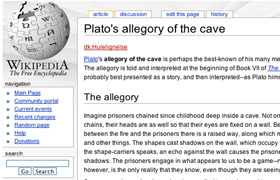http://en.wikipedia.org/wiki/Plato's_allegory_of_the_cave

Plato's famous story from Book VII of The Republic implies that much of what we think we know is in reality a mere shadow. It is only by stepping out of our very limited environment that we will be able to determine the difference between reality and illusion. The story in short challenges to know that difference and to demand proof for what we believe.
The expectation of textual authority differs greatly when we leave the print media and enter the unknown territory of the Internet. The challenge is always to establish whether a particular text has any validity, but with print sources we are usually able to verify an author's credibility before following hir in the discourse. The interactive imperative of the Internet requires the opposite. We have to put our minds through before knowing who the author is and before we establish credibility. We must enter into a relationship with the author and at least to some degree engage with hir ideas in order to be able to assess the validity of either.
On the surface of it, that might seem to be quite easily solved. There are, for instance, some sensible and practical evaluation criteria offered at http://foundations.arts.ubc.ca/fedoruk/websources.htm. And here is the trap: since these criteria are also contained in a self-published, unjuried site, we cannot know for certain if they themselves are valid. It would seem that the Internet publisher is in danger of getting caught in a circuitous maze of questionable information.
We tend not to think that happens in print publication. Very often, information is given credence solely because it has appeared in print. Although there are more controls and possibly more reliability in the accreditation of print souces, the fact remains that authority must always be verified. If we depend on a particular review or reviewer, then it is incumbent on us to check the reliability of the review. We probably do that by consulting another source, whose reliability must also be verified. This could go on forever, thought there are two ways out out of the dilemma. We could just establish or agree on a source whose relaiability and authority are beyond question, then just accept the judgement of that source. There are any number of academic or professional examples of the practicability of this approach. Unfortunately there are just as many political or religious examples to illustrate the danger.
http://en.wikipedia.org/wiki/Wikipedia:1911_Encyclopaedia_Britannica
Another solution is to establish a source or a set of evaluation criteria so basic, so obvious that we have to accept it as axiomatic. The 1911 edition of the Encyclopaedia Britannica is now out of copyright, so it can be used as source material for Internet publication. Where this material may have once been accepted as accurate, and may have been used as primary information, it is now necessary to apply some evaluation criteria to the primary material itself. Wikipedia has developed a very intelligent set of criteria for evaluating the material It applies specifically to the 1911 text, but it is easy to see how similar thinking might be applied to other to This is a basic, axiomatic set of criteria that can themselves be evaluated using nothing more than common sense. If text from the 1911 Encyclopedia can be considered authoritative within those criteria, then it can then be used as a source, and a comparison for additional research.
Clearly more responsibility lies with the individual reader and more emphasis has to be placed on the hir individual ability to analyse information. There is a mass of information available, and where we tend to trust print sources, our initial inclination is to distrust Internet sources. Neither position is safe. The individual reader must be able to distinguish the authentic and accurate information whether in print or on the Internet. The need to personally come to trust the reliability the author and the text has always existed, but here again it is made nore immediate by interactive technology. Ultimately each reader will have to establish an individual relationship with each author. This is a bit more demanding than some forms of research, and the results may be completely unpredictable, but in the long run I find it easier to trust the discourse that develops in this environment.
Wikipedia is a collective work, its articles are submitted by interested individuals who presumably have some knowledge of their subject. But the articles can be edited by readers, so information is constantly being expanded, corrected and improved. The information is therefore part of a collective set of knowledge. And it seems to me to be closer to the traditional listener/storyteller relationship that existed around our ancestors' campfires.